|
|
Oxide Neuron Devices and Their Applications in Artificial Neural Networks
LI Zongxiao, HU Lingxiang, WANG Jingrui, ZHUGE Fei
2024 Vol. 39 (4): 345–358
 Abstract
Abstract(
490 )
 HTML
HTML(
19)
 PDF
PDF(3104KB)(
425
)
Nowadays, artificial intelligence (AI) is playing an increasingly important role in human society. Running AI algorithms represented by deep learning places great demands on computational power of hardware. However, with Moore's Law approaching physical limitations, the traditional Von Neumann computing architecture cannot meet the urgent demand for promoting hardware computational power. The brain-inspired neuromorphic computing (NC) employing an integrated processing-memory architecture is expected to provide an important hardware basis for developing novel AI technologies with low energy consumption and high computational power. Under this conception, artificial neurons and synapses, as the core components of NC systems, have become a research hotspot. This paper aims to provide a comprehensive review on the development of oxide neuron devices. Firstly, several mathematical models of neurons are described. Then, recent progress of Hodgkin-Huxley neurons, leaky integrate-and-fire neurons and oscillatory neurons based on oxide electronic devices is introduced in detail. The effects of device structures and working mechanisms on neuronal performance are systematically analyzed. Next, the hardware implementation of spiking neural networks and oscillatory neural networks based on oxide artificial neurons is demonstrated. Finally, the challenges of oxide neuron devices, arrays and networks, as well as prospect for their applications are pointed out.
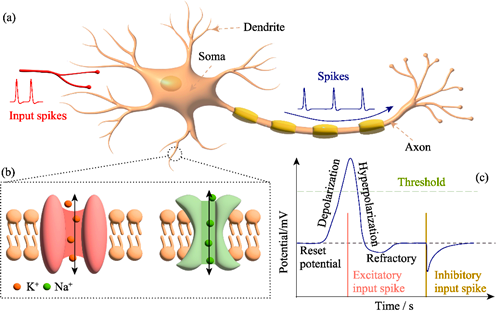
|
|
|
Influence of Upconversion Luminescent Nanoparticles on Hysteresis Effect and Ion Migration Kinetics in Perovskite Solar Cells
YU Man, GAO Rongyao, QIN Yujun, AI Xicheng
2024 Vol. 39 (4): 359–366
 Abstract
Abstract(
289 )
 HTML
HTML(
13)
 PDF
PDF(2082KB)(
1068
)
Hysteresis effect greatly impacted performance and stability of perovskite solar cells. Ion migration and the resulting accumulation of interface ions were widely recognized as the most important origins. In this study, upconversion luminescent nanoparticles (UCNP) were used to modify the interface of the electron transport layer/perovskite active layer and the intrinsic perovskite active layer, and the effects of UCNP on the morphology, structure, spectral/optoelectronic properties, and ion migration kinetics of perovskite were systematically explored. The results indicated that the device with UCNP modified perovskite active layer has the best photoelectric conversion efficiency (PCE, 16.27%) and significantly improves the hysteresis factor (HF, 0.05). Furthermore, circuit switching transient optoelectronic technology was employed to investigate the ion migration kinetics without interference from photo-generated carriers, revealing the dual role of UCNP in suppressing ion migration and accumulation during the optoelectronic conversion process of perovskite solar cells. On the one hand, UCNP formed barrier layers that hinder ion accumulation. On the other hand, UCNP infiltrated into grain boundaries of perovskite phase during annealing, hindering ion migration and reducing the recovery voltage from 0.43 V to 0.28 V. The mechanism of carriers and ions interaction was explained based on the polarization-induced trap state model to declare the process of UCNP suppressing the hysteresis of perovskite photovoltaic devices. This work provides effective solution for regulating the hysteresis of perovskite solar cells.
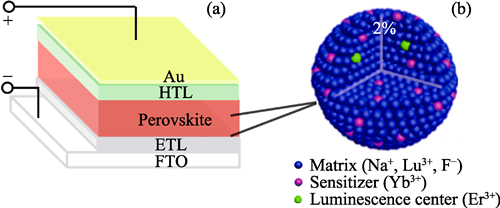
|
|
|
LaNi0.6Fe0.4O3 Cathode Contact Material: Electrical Conducting Property Manipulation and Its Effect on SOFC Electrochemical Performance
ZHANG Kun, WANG Yu, ZHU Tenglong, SUN Kaihua, HAN Minfang, ZHONG Qin
2024 Vol. 39 (4): 367–373
 Abstract
Abstract(
255 )
 HTML
HTML(
7)
 PDF
PDF(3002KB)(
302
)
In order to fulfil the requirement of low area specific resistance and highly stable cathode contact material in planar type solid oxide fuel cell (SOFC) stack assembling, this work investigated the electrical property evolution of LaNi0.6Fe0.4O3 (LNF) with manipulated particle size and its effect on SOFC electrochemical performance. The optimized pre-treatment strategies of LNF were obtained with decreasing ASR, improving SOFC single cell performance and thermal cycling stability. Results show that, the dry-pressed LNF-2 and the high-temperature sintering-pre-treated LNF-3 possess smaller area specific resistances of 0.074 and 0.076 Ω·cm², respectively, more stable particle sizes with shorter conditioning state and faster transfer into steady state after applying 1 A/cm2 current load at 750 ℃. Specifically, the single cell with LNF-2 shows improved peak power density of 0.94 W/cm2 compared to 0.66 W/cm2 of LNF without treatment at 750 ℃. However, it exhibits significant performance degradation during thermal cycling, decreasing by 20%. In contrast, the peak power density of LNF-3 single cell decreases by only 4% after 20 thermal cycles. This work is expected to provide guideline and valued reference for reliable SOFC stack assembling and stable operation.
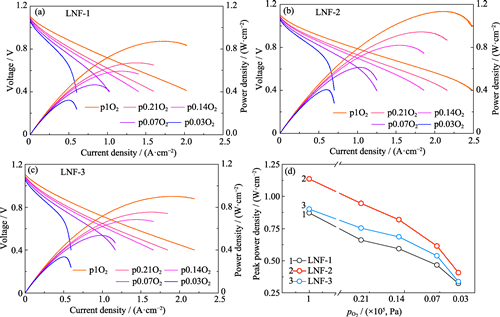
|
|
|
Electrocatalytic Water Splitting over Nickel Iron Hydroxide-cobalt Phosphide Composite Electrode
YANG Bo, LÜ Gongxuan, MA Jiantai
2024 Vol. 39 (4): 374–382
 Abstract
Abstract(
354 )
 HTML
HTML(
22)
 PDF
PDF(4706KB)(
641
)
NiFeOH/CoP/NF composite electrode was fabricated by constructing a metal hydroxide layer on the surface of cobalt phosphide via hydrothermal, phosphating, and electrodeposition methods. The electrolytic water splitting to hydrogen performance by as-prepared electrode was investigated in 1.0 mol/L KOH medium. NiFeOH/CoP/NF composite electrode exhibited excellent water electrolysis performance, and the required overpotentials for HER and OER at 100 mA/cm2 current density were 141 and 372 mV, respectively. When NiFeOH/CoP/NF electrode served as both cathode and anode for water splitting, only 1.61 V voltage was required to reach current density of 10 mA/cm2. Because NiFeOH protection layer enhanced the electrocatalytic activity and stability of CoP for water splitting, NiFeOH/CoP/NF composite electrode exhibited high stability during the galvanostatic electrolysis in the HER and OER, and its activity could maintain 60000 s without significant performance degradation. The photovoltaic-electrolytic water cell constructed with two NiFeOH/CoP/NF electrodes and GaAs solar cell showed 18.0% efficiency of solar to hydrogen under 100 mW/cm2 simulated solar irradiation and worked stably for 200 h.
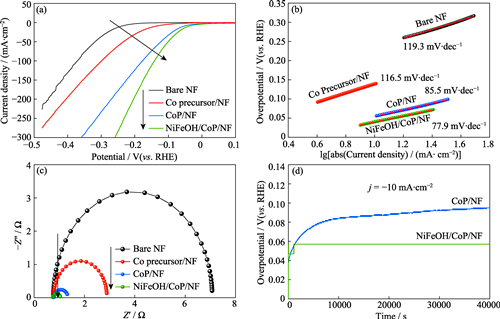
|
|
|
Sandwich Structured Ru@TiO2 Composite for Efficient Photocatalytic Tetracycline Degradation
WANG Zhaoyang, QIN Peng, JIANG Yin, FENG Xiaobo, YANG Peizhi, HUANG Fuqiang
2024 Vol. 39 (4): 383–389
 Abstract
Abstract(
297 )
 HTML
HTML(
10)
 PDF
PDF(1702KB)(
266
)
TiO2 nanomaterials are widely used photocatalysts due to high photocatalytic activity, good chemical stability, low cost, and nontoxicity. However, its lower photon utilization efficiency is still limited by larger bandgap width and higher recombination rate between photon and hole. In this study, two-dimensional TiO2 nanosheets were synthesized via microetching, which were then inserted by ruthenium atoms to form an efficient photocatalyst Ru@TiO2 with sandwich structure. The surface morphology, electronic structure, photoelectric properties, and photocatalytic degradation performance of tetracycline hydrochloride of Ru@TiO2 sandwich structure were investigated using different measurements. Results indicated that the material’s photoresponse range extended from UV to visible- near-infrared regions, improving photon absorption and carrier separation efficiency while enhancing photocatalytic activity. Under simulated sunlight irradiation (AM 1.5 G, 100 mW·cm-2) for 80 min, sandwich structured Ru@TiO2 efficient photocatalyst exhibited superior degradation performance on tetracycline hydrochloride with a degradation efficiency up to 91.91%. This work offers an effective way for the construction of efficient TiO2 based photocatalysts.
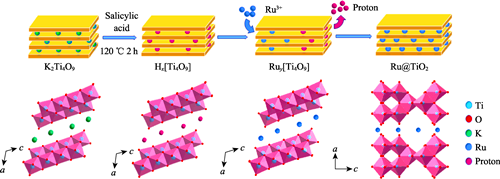
|
|
|
Enhanced Styrene Adsorption by Grafted Lactone-based Activated Carbon
WU Guangyu, SHU Song, ZHANG Hongwei, LI Jianjun
2024 Vol. 39 (4): 390–398
 Abstract
Abstract(
179 )
 HTML
HTML(
2)
 PDF
PDF(11161KB)(
254
)
Activated carbon's porous nature and high specific surface area make it an effective tool for adsobing waste gas containing styrene. However, the mechanism by which oxygen-containing functional groups adsorb weak-polar styrene remains unclear. This study described the preparation of the modified activated carbon materials AC-S and AC-N using the acid leaching method. The pore structure and specific surface area of modified activated carbon, the evolution of oxygen-containing functional groups, and their impact on the styrene-adsorbing performance were investigated. The results demonstrated that acid modification significantly improved the styrene-adsorbing capacity of activated carbon. Physical and chemical adsorption impacted both modified and unmodified activated carbon materials, as determined by the adsorption kinetics studies and isotherm fitting analyses. Monolayer adsorption was more likely to occur on modified activated carbon. HNO3-modified activated carbon (AC-N) maintained its effective styrene adsorption pore size range. The increasing number of oxygen-containing functional groups on the surface improved the styrene adsorption performance of AC-N. Study of oxygen-containing functional groups on the surface revealed that lactone group was a key factor in improving the modified activated carbon's ability to adsorb styrene. Density functional theory (DFT) calculations showed that lactone group on AC-N strongly interacted with the vinyl group in styrene, thereby enhancing the styrene adsorption performance of modified activated carbon.
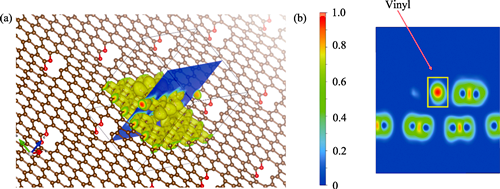
|
|
|
Process Control of PyC Interphases Microstructure and Uniformity in Carbon Fiber Cloth
XUE Yifan, LI Weijie, ZHANG Zhongwei, PANG Xu, LIU Yu
2024 Vol. 39 (4): 399–408
 Abstract
Abstract(
160 )
 HTML
HTML(
5)
 PDF
PDF(31277KB)(
302
)
Mechanical properties of ceramic matrix composites are highly dependent on the microstructure and homogeneity of the interphase. This study examined the influence of process factors, such as deposition temperature, propylene partial pressure, retention time, and hydrogen partial pressure, on the microstructure and homogeneity of PyC interphase deposited on the surface of carbon fiber cloth. Various characterization techniques were used to characterize the microstructure and texture of the PyC interphase, and the inherent correlation between microstructure, uniformity, and process parameters was analyzed. The results show that increasing temperature and propylene partial pressure lead to a more regular texture in the interphase, while decreasing hydrogen partial pressure has the opposite effect, and retention time has little effects. Additionally, an increase in deposition temperature and propylene partial pressure leads to an uneven distribution of interphase thickness, and overhigh propylene partial pressure directly leads to the production of carbon black. Increasing retention time helps to improve interphase homogeneity. The interphase uniformity of medium and high textures firstly drops and then increases when the hydrogen partial pressure increases, but the interphase uniformity of low texture is less impacted. Ultimately, the study clarified the growth method of the PyC interphase. Furthermore, the research delved into the process factors influencing the texture and uniformity of the PyC interphase, which provided a basis for the fine regulation of PyC interface phase in the future.
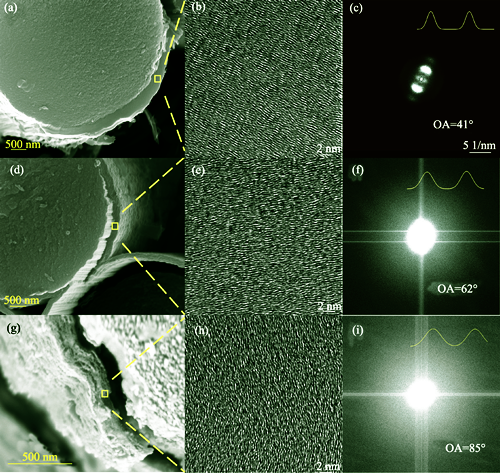
|
|
|
Hydrothermal-sintering Preparation of Cr2+:ZnSe/ZnSe Nanotwins with Core-shell Structure
ZHANG Tingting, WANG Fangyuan, LIU Changyou, ZHANG Guorong, LÜ Jiahui, SONG Yuchen, JIE Wanqi
2024 Vol. 39 (4): 409–415
 Abstract
Abstract(
192 )
 HTML
HTML(
5)
 PDF
PDF(5889KB)(
251
)
Cr2+ doped ZnSe nanocrystals are an important type of mid-infrared materials. ZnSe-based semiconductor nanocrystals with core-shell structure have shown excellent optical, electrical and catalytic properties. The defects of nanocrystals are one of the important factors affecting their properties. For example, nanocrystals with twinned structure have higher strength and hardness. In order to improve the comprehensive performance of doped nanocrystals, Cr2+:ZnSe/ZnSe nanocrystals with core-shell structure were prepared by two-step hydrothermal processes, using soluble Zn salt as Zn source, newly prepared NaHSe solution as Se source, and Cr(AC)2 as doping source, and chemically stable nanocrystals at room temperature were obtained by sintering at 400 and 800 ℃ under protection of argon or high vacuum, respectively. Their structural and morphological characterization results show that the nanocrystalline size is mainly concentrated in the range of 20-30 nm, the shell thickness is about 2.6 nm, and the nanocrystals have delamination defects, thus twins are developed. The analysis results show that the twin plane is (111), the angle between the adjacent two crystal planes is 70.02°± 0.5°. The twin density of the sample increases with the increase of the crystallinity, which indicates that release of lattice distortion energy leads to formation of delamination and twin. Meanwhile, the twin growth can be explained by dislocation induced nucleation-growth. XPS analysis shows that Cr elements with a valence of +2 exist in the nanocrystals, and the reflection spectroscopy test shows that nanocrystals have an absorption band around 1775 nm, indicating that the prepared nanocrystals with twins have a promising mid-infrared luminescent property.
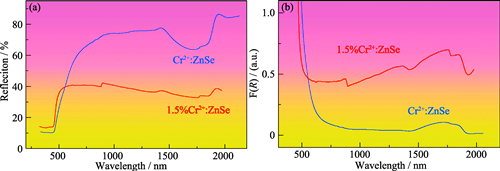
|
|
|
Heteroepitaxial Diamond Nucleation and Growth on Iridium: First-principle Calculation
WANG Weihua, ZHANG Leining, DING Feng, DAI Bing, HAN Jiecai, ZHU Jiaqi, JIA Yi, Yang Yu
2024 Vol. 39 (4): 416–422
 Abstract
Abstract(
339 )
 HTML
HTML(
11)
 PDF
PDF(6717KB)(
377
)
Heteroepitaxy provides an effective path for the synthesis of diamond wafers. After more than 20 years of development, the diamond nucleation and growth technology on iridium substrates has enabled to prepare crystals with a maximum diameter of 3.5 inches, which opens a door to application diamond as ultimate semiconductor in the future chip industry. However, a series of problems that occur on heterogeneous substrates, such as surface nucleation, bias process window, and diamond epitaxial growth, need to overcome from the perspective of growth thermodynamics. In this study, aiming at the key issue how diamond can achieve epitaxial nucleation and growth in chemical vapor deposition atmosphere, a simulation study was carried out on the nucleation and growth process of diamond at the atomic scale based on the first-principle calculation. The results show that the adsorption of C atoms on the surface of the Ir substrate is more stable than that on the bulk phase, which indicates that diamond nucleation can only occur on the substrate surface. The number of C atoms of sp3 hybridization in the amorphous hydrogenated carbon layer increases firstly and then decreases with the increase of ion kinetic energy under ion bombardment, confirming the existence of the ion kinetic energy or bias voltage window in the high-density nucleation of diamond. The interfacial binding energy is the lowest (about -0.58 eV/C) when diamond is epitaxially grown along the Ir substrate, meaning that the interface binding energy is the decisive thermodynamic factor for the epitaxial growth. In conclusion, this study clarifies the thermodynamic mechanism of single crystal diamond epitaxial growth under the bias-assisted ion bombardment, and points out a great significant guidance for the growth of diamond and other carbon based semiconductors.
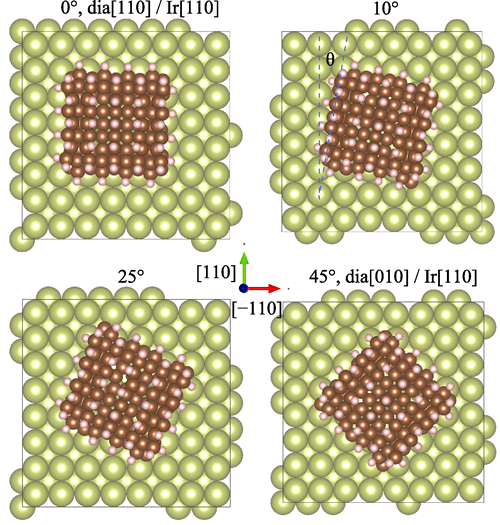
|
|
|
Linear-like NaNbO3-based Lead-free Relaxor Antiferroelectric Ceramics with Excellent Energy-storage and Charge-discharge Properties
SHI Ruijian, LEI Junwei, ZHANG Yi, XIE Aiwen, ZUO Ruzhong
2024 Vol. 39 (4): 423–431
 Abstract
Abstract(
241 )
 HTML
HTML(
4)
 PDF
PDF(2482KB)(
301
)
Antiferroelectric (AFE) materials exhibit great potential in the application of high-performance dielectric energy storage capacitors due to their electric field-induced AFE-ferroelectric (FE) phase transition. However, the large hysteresis of field-induced phase transition makes it difficult to simultaneously achieve high energy-storage density (Wrec) and efficiency (η) for AFEs. This work improved the energy-storage performance of NaNbO3-based lead-free AFE ceramics by introducing the third group Bi(Mg0.5Ti0.5)O3 into 0.76NaNbO3-0.24(Bi0.5Na0.5) TiO3 to regulate its relaxation characteristics. Novel lead-free AFE ceramics, (0.76-x)NaNbO3-0.24(Bi0.5Na0.5)TiO3-xBi(Mg0.5Ti0.5)O3, were prepared by a traditional solid-state reaction method. Their phase structure and microstructure as well as dielectric, energy-storage, and charge-discharge characteristics were studied. The results indicated that introduction of Bi(Mg0.5Ti0.5)O3 obviously enhanced the dielectric relaxor behavior of the matrix without changing its AFE R-phase structure, which led to the significantly reduced polarization hysteresis. Especially, a linear-like polarization-field hysteresis loop with extremely-low hysteresis was obtained in the composition of x=0.050. At the same time, microstructure of the ceramic was effectively optimized, its dielectric constant decreased, and its breakdown strength had significant enhanced. As a result, a high Wrec=3.5 J/cm3 and a high η=93% were simultaneously achieved under a moderate electric field of 30 kV/mm in the x=0.050 ceramic. Moreover, the x=0.050 ceramic also exhibited excellent charge-discharge characteristics with a high-power density PD=131(1±1%) MW/cm3, a high discharge energy density WD=1.66(1±6%) J/cm3 and a fast discharge rate t0.9<290 ns at 20 kV/mm. The charge-discharge properties maintained good stability within a wide temperature range of 25-125 ℃. These results indicate that 0.71NaNbO3-0.24(Bi0.5Na0.5)TiO3-0.050Bi(Mg0.5Ti0.5)O3 ceramics can be expected to be applied in high-power energy-storage capacitors.
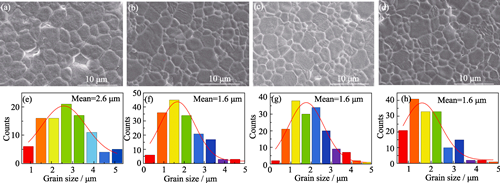
|
|
|
Electrochromic Intelligent Visual Humidity Indication System
ZHEN Mingshuo, LIU Xiaoran, FAN Xiangqian, ZHANG Wenping, YAN Dongdong, LIU Lei, LI Chen
2024 Vol. 39 (4): 432–440
 Abstract
Abstract(
254 )
 HTML
HTML(
4)
 PDF
PDF(5871KB)(
370
)
In recent years, humidity sensors have attracted widespread attention from researchers in fields such as food safety and soil monitoring. Traditional humidity sensors exhibit the advantages of good stability and high sensitivity. However, most humidity sensing systems convert humidity signals into recognizable waveforms through wired connections and large external devices, making it impossible to achieve real-time visual monitoring of changes in humidity information. Currently, direct conversion of humidity information into visible color signals by eyes provides an ideal solution to the aforementioned problems but still lacks intelligent monitor capacity. This study integrated humidity sensors and electrochromic devices (ECDs) to prepare an intelligent visual humidity monitoring system. By converting humidity signals into voltage signals to drive ECDs, stable and reversible color change in the system could be achieved. The ECDs were prepared using tungsten trioxide (WO3) as the negative electrode and zinc foil (Zn) as the positive electrode. Based on the output voltage of the humidity sensor, it achieves transitions between different working states, thereby generating color signals that can be observed by the naked eyes. Electrochemical performance and electrochromic performance of ECDs were tested and characterized by using a UV-visible spectrophotometer and an electrochemical workstation. Subsequently, the performance of the conditioning circuit was analyzed using an oscilloscope and a humidity generation platform. The results show that the intelligent electrochromic humidity indicator has good stability and rapid response performance, where the coloring time and fading time are only 7.5 s and 4.5 s, respectively. After 300 cycles, the optical modulation (ΔT) is basically maintained the same as the initial value, and the retention rate can reach more than 95%. Therefore, this visual humidity indication system which possesses novel design and simple structure has promising broad application in fields such as artificial intelligence and intelligent agriculture.
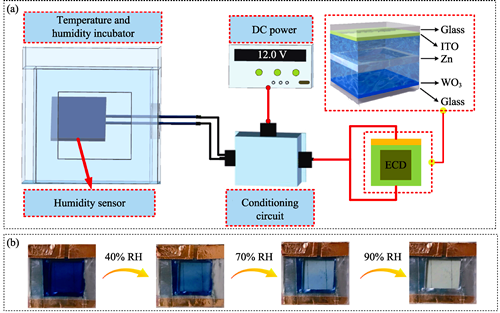
|
|
|
Broadband-modulated Photochromic Smart Windows Based on Oxygen-containing Gadolinium Hydride Films
LI Zhongshao, LI Ming, CAO Xun
2024 Vol. 39 (4): 441–448
 Abstract
Abstract(
181 )
 HTML
HTML(
5)
 PDF
PDF(10967KB)(
226
)
Photochromic windows are considered an effective and energy-efficient smart window due to their simple structure, passive light modulation, and zero-energy input. However, the research on photochromic smart windows has rarely addressed the mid-infrared (MIR) bands, which greatly limits energy-saving efficiency. Here, we report that rare-earth oxygen-containing hydrides (ReOxHy) films grown on ITO substrates have the ability to be broadband modulated. The developed photochromic smart window is capable of automatically adjusting emissivity by sensing light intensity while maintaining visible and near-infrared (NIR) modulation (ΔTsol = 35.1%, ΔTlum = 37%, and Δε8-13 μm = 0.12). We also achieved one-step preparation of GdOxHy with improved stability by optimising the preparation atmosphere. The photochromic mechanism was analyzed by comprehensive characterization. In conclusion, this passive and synergistic modulation method across the visible-NIR-MIR is expected to greatly advance the field of photochromic smart windows.
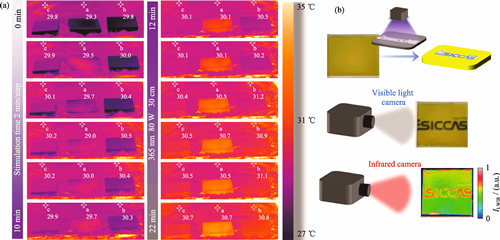
|
|
|
Effect of Pb2+ on the Luminescent Performance of Borosilicate Glass Coated CsPbBr3 Perovskite Quantum Dots
YUE Zihao, YANG Xiaotu, ZHANG Zhengliang, DENG Ruixiang, ZHANG Tao, SONG Lixin
2024 Vol. 39 (4): 449–456
 Abstract
Abstract(
155 )
 HTML
HTML(
12)
 PDF
PDF(2205KB)(
271
)
Perovskite CsPbBr3 quantum dots (PQDs) encapsulated within borosilicate glass can markedly improve their stability, expanding their applicability in sectors under lighting and display of light emitting diode (LED). However, this encapsulation has unintended consequence of reducing both the photoluminescence (PL) intensity and PL quantum yields (PLQY). This research aims to enhance the PL intensity of CsPbBr3 perovskite quantum dots glass (PQDs@glass) by exploring the effects of thermal induction temperature and Pb2+ content on its structural properties. The results demonstrate that the optimal thermal induction temperature for maximizing PL intensity is 460 ℃, with a Pb2+ concentration of 6 mol. The study revealed that the increase in Pb2+ concentration led to the densification of the glass network structure and altered the diffusion behavior of glass components. This alteration affected the crystallization process of PQDs, which ultimately resulted in variations in the luminous intensity of PQDs@glass. This study achieved a highly desirable PLQY of 95.6% for PQDs@glass and successfully carried out size-controllable preparation of PQDs within a borosilicate glass matrix. Remarkably, the obtained results show that over 86% of the obtained PQDs particles fall within a narrow size range of 6-14 nm with average diameter of 10 nm, leading to a well-defined size distribution. Notably, these PQDs exhibit exceptional stability, as evidenced by their ability to retain an extraordinary 98.9% of the initial emission intensity following ten consecutive thermal cycles spanning from room temperature to 200 ℃. Finally, to verify its applicability in LED lighting and display, the obtained PQDs@glass powder was blended with polydimethylsiloxane (PDMS), yielding exemplary LED devices which exhibit an exceptional color gamut range surpassing 110% of the standard RGB (sRGB) color space. In conclusion, this study lays the groundwork for the scalable synthesis of PQDs@glass and paves the way for its utilization in the realm of LED device technology.
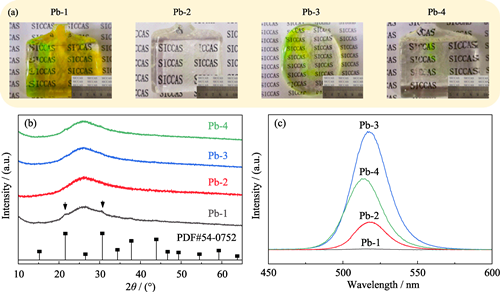
|
|